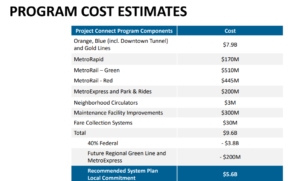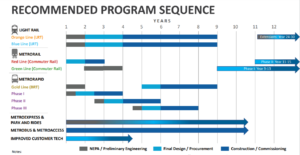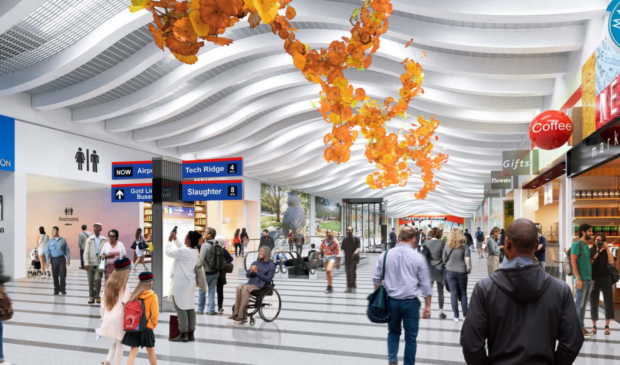Council lands on long-term payment method for Project Connect
Tuesday, March 10, 2020 by
Ryan Thornton In capital costs alone, the city and its residents can expect to contribute around $5.6 billion for the combined pieces of Project Connect.
That money will cover investments for two light rail lines, several bus rapid transit “lite” routes and expanded commuter rail, but all of those investments will require funds for operations, maintenance, repair, and replacement once in service.

In previous discussions, the Capital Metropolitan Transportation Authority and City Council proposed two primary sources of funds from residents: a bond for capital costs and a tax rate election for most everything else. Now, the idea of an initial bond appears to have been dropped in favor of asking voters to raise the property tax rate above the state’s 3.5 percent cap to cover the entire system.
In contrast to a one-time bond, a tax rate increase can provide an ongoing source of revenue to keep the system in good condition.
Many regions, Council Member Jimmy Flannigan said, “underfunded their capital renewal and their operations and maintenance and … 20 or 30 years later they don’t have a sustainable source of funding and now they find that their systems are pummeled. We won’t make those mistakes with this plan.”
In the first year, the 9- to 10-cent tax rate increase could add up to $324 to the tax bill of the median home. That’s assuming a 30-year timeline to complete the entire system, with most of the components, including the Orange and Blue lines, on the ground around 2028.
Because most city residents are renters, Flannigan said that estimate is not a good indicator of the financial impact the system will have on most people. Mayor Pro Tem Delia Garza suggested a better way to communicate costs to the public is to calculate estimates based on geographical area and deliver those figures as part of upcoming community outreach meetings.
The 30-year timeline spreads out the financial burden over time but also means that some components won’t be in place for many years. As Travis County Precinct 1 Commissioner Jeff Travillion noted, the $520 million Green Line commuter rail route would not begin the final design and construction phase until about the time that the Orange and Blue lines are complete. The last pieces to come into place would be the Orange Line extensions between Stassney and Slaughter lanes and between North Lamar Transit Center and Tech Ridge.

Capital Metro CEO Randy Clarke said staggering the projects is an intentional choice. Since the Federal Transit Administration only considers grants for specific routes as opposed to entire systems, the agency aims to break up the individual project timelines based on specific goals for each route.
As a consequence, spreading the project over a longer time opens up the possibility for economic growth to help cover the costs. Given the current rate of growth downtown, Council Member Greg Casar said he would expect the new system to spur even more growth, mitigating the burden on individuals.
Greg Canally, financial officer for the city, said the Central Business District has grown at three times the rate of the rest of the city over the last decade, adding an extra $25 million to $30 million in revenue.
“If we see that growth, or even half of that growth that we’ve seen, I think we’d see again the continued acceleration of (commercial development) paying for a lot of this and then, ultimately as well, the tax rate would be coming down,” Canally said. “The more that growth occurs, we’re going to see that tax rate come down over the decade.”
Council Member Alison Alter said the tax rate election is the best funding option given current constraints by the state and federal governments, but said the city should plan for the event that things could change. For example, she said, state law could be amended so that street impact fees can be used for public transit as well as road infrastructure.
“I think we should be planning for some of those factors to be changing over time and be more favorable to the kinds of investments that we’re making,” Alter said. “Some investments that are relatively small for the state could make a big difference in terms of how this bond plays out over time and would free us to be able to make choices about whether we wanted to accelerate the buildout or if we wanted to reduce the tax.”
Clarke said new funding sources should open up eventually, but didn’t say whether that’s likely to be within the timeline of the buildout.
“We think, long-term, as a country, there will be other sources available for transit,” he said. “(There will be) too many human beings living in urban centers, and whether that’s federal money or state money, that could be an opportunity.”
In considering costs, Council Member Paige Ellis said it’s important to consider that transit can provide families and individuals an alternative to the expenses of owning and operating a private car. Beyond financial costs, she said, we should also consider that transit can help fight climate change. “That’s a really important part of this conversation – as we start working through the dollars and cents and what that means – for people to really look at the big picture.”
Download (PDF, 355KB)
Map, charts and rendering of subway station courtesy of Capital Metro.
The Austin Monitor’s work is made possible by donations from the community. Though our reporting covers donors from time to time, we are careful to keep business and editorial efforts separate while maintaining transparency. A complete list of donors is available here, and our code of ethics is explained here.
You're a community leader
And we’re honored you look to us for serious, in-depth news. You know a strong community needs local and dedicated watchdog reporting. We’re here for you and that won’t change. Now will you take the powerful next step and support our nonprofit news organization?












